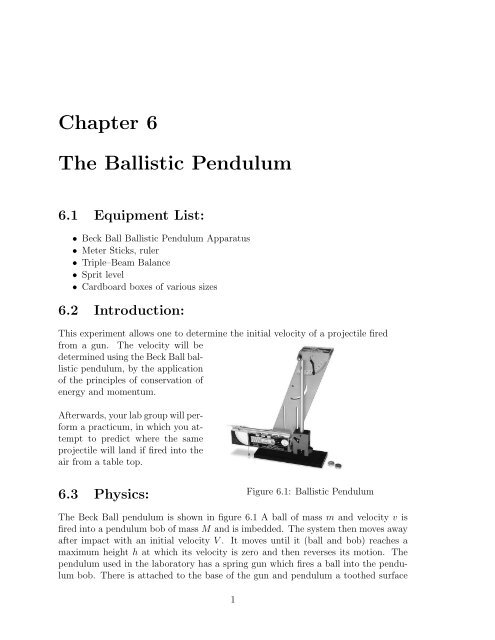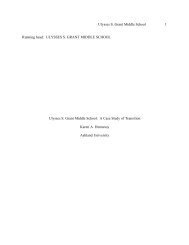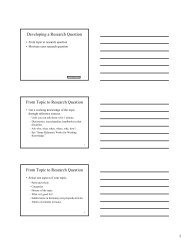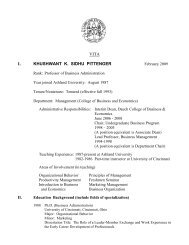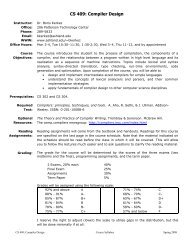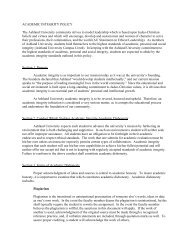Chapter 6 The Ballistic Pendulum
Chapter 6 The Ballistic Pendulum
Chapter 6 The Ballistic Pendulum
You also want an ePaper? Increase the reach of your titles
YUMPU automatically turns print PDFs into web optimized ePapers that Google loves.
<strong>Chapter</strong> 6<strong>The</strong> <strong>Ballistic</strong> <strong>Pendulum</strong>6.1 Equipment List:• Beck Ball <strong>Ballistic</strong> <strong>Pendulum</strong> Apparatus• Meter Sticks, ruler• Triple–Beam Balance• Sprit level• Cardboard boxes of various sizes6.2 Introduction:This experiment allows one to determine the initial velocity of a projectile firedfrom a gun. <strong>The</strong> velocity will bedetermined using the Beck Ball ballisticpendulum, by the applicationof the principles of conservation ofenergy and momentum.Afterwards, your lab group will performa practicum, in which you attemptto predict where the sameprojectile will land if fired into theair from a table top.6.3 Physics:Figure 6.1: <strong>Ballistic</strong> <strong>Pendulum</strong><strong>The</strong> Beck Ball pendulum is shown in figure 6.1 A ball of mass m and velocity v isfired into a pendulum bob of mass M and is imbedded. <strong>The</strong> system then moves awayafter impact with an initial velocity V . It moves until it (ball and bob) reaches amaximum height h at which its velocity is zero and then reverses its motion. <strong>The</strong>pendulum used in the laboratory has a spring gun which fires a ball into the pendulumbob. <strong>The</strong>re is attached to the base of the gun and pendulum a toothed surface1
2 CHAPTER 6. THE BALLISTIC PENDULUMwhich catches a pawl on the pendulum bob at its maximum height of swing.In order to determine the velocity v with which the ball is fired, it is necessary to usethe principles of conservation of momentum and energy. If we apply the principle ofconservation of momentum to the system, the momentum of the ball before impact ismv. <strong>The</strong> momentum at the instant the system moves away after impact is (m+M)V .<strong>The</strong>refore we have:mv = (m + M)V (6.1)At collision a significant fraction of the kinetic energy is dissipated into irrecoverableforms due to the deformation of the ball catcher springs in the bob, the friction betweenthe ball and bob, and sound waves. After the ball has become imbedded in thebob, assuming no friction in the pendulum mount, the total mechanical energy is aconstant.If we let position (1) be at the bottom and position (2) be at the maximum height ofthe swing, and define ∆h ≡ h 2 − h 1 , then:(M + m)g∆ = 1 2 (M + m)V 2 (6.2)By combining equations 6.1 and 6.2, v can be found from the experiment.6.4 Laboratory Techniques:6.4.1 StatisticsSuppose that the same physical quantity, x, is measured repeatedly (say, n times)yielding a number of results: x i , i = 1ton. <strong>The</strong> best estimate of the value of x is thenthe mean:¯x = 1 n∑x i (6.3)nFurthermore, the best estimate of the measurement uncertainty in the quantity isgiven by the standard deviation:i=1σ x =√∑ (x1 − ¯x) 2n − 1(6.4)Almost all scientific calculators have the ability to calculate the mean and standarddeviation of a set of measurements.6.4.2 Error PropagationSuppose further that some other physical quantity of interest, y, depends directly onthe value of the measured quantity, x, by the function y = f(x). <strong>The</strong> uncertainty in
6.4. LABORATORY TECHNIQUES: 3y may be estimated using calculus from the uncertainty in x by the relation: 1σ y = ∂f(x)∂x σ x (6.5)By using the statistical standard deviation in a quantity as its uncertainty, we mayuse an interpretation from the world of statistics: about 2 of the time, a measurement3of the quantity will fall within one standard deviation of the mean.In previous experiments you have encountered instances in which you needed to considerthe “propagation of uncertainty”. <strong>The</strong> first was that of a quantity y which isfound by multiplying some measured quantity x by a constant k:y = kxIn this case, the uncertainty in y is found from:δy = kδxA second instance was that of a quantity z which is found from the sum (or difference)of two measured quantities x and y:z = x ± yIn this case, the uncertainty in z is the sum of the absolute uncertainties in x and y:δz = δx + δyNext, when some quantity z depends on the product (or quotient) of two measuredquantities x and y:z = x × y or z = x ÷ ythen the relative uncertainty in z is the square root of the sum of the squares of therelative uncertainties in x and y:√ (δx ) 2 ( ) 2δzδyz = +x yWe can also add one new rule of error propagation, if a quantity y depends uponsome power of x, i.e.:y = x pthen:δyy = pδx x1 For non-calculus technics for propagation of error refer to Appendix ??.
4 CHAPTER 6. THE BALLISTIC PENDULUM6.5 <strong>Pendulum</strong> Experiment6.5.1 Procedure1) Detach the pendulum and weigh the ball and pendulum separately. record theirmasses:m = gm M = gm2) Place the ball inside the pendulum bob, and balance the ball/bob combination onthe edge of a ruler in order to locate its center of mass. Mark the center of mass pointon the pendulum using a pencil.3) Reattach the pendulum and let it hang freely. measure the height of the center ofmass pencil mark from the base of the apparatus. Record this value:h 1 =cm4) Place the ball on the guide rod and push it toward the gun until the triggermechanism “catches”. Fire the gun and measure the final height of the bob/ball centerof mass. Make five measurements, find their average and estimate an uncertainty inthis average.Trial h 2 (First Spring Position)123 Average h 2 ± cm455) If you thought it was hard cocking the gun into its first position, you are in for areal treat! <strong>The</strong>re are a total of three spring positions in the cocking system. To cockthe gun to its second position, first cock it into the first position. <strong>The</strong>n, while holdingthe ball firmly with your left thumb and forefinger, depress the trigger and push theball another half centimeter so that the trigger clicks up into its second slot. To cockthe gun into its third position, repeat the above procedure and press the ball anotherhalf centimeter so that the trigger clicks into the third slot.Repeat your measurements from part 4, for both the second and third trigger positionsṪrial h2 (Second Spring Position)123 Average h 2 ± cm45
6.6. PROJECTILE PRACTICUM: 5Trial h 2 (Third Spring Position)123 Average h 2 ± cm456.5.2 AnalysisFor each of the three spring positions, calculate average height change of the ball/bobcombination. Use this to calculate the average change in potential energy. Show allyou work below.Next calculate the velocity of the ball/pendulum bob combination at the bottom ofits swing (V ) and the initial velocity of the ball before the collision (v) for each ofthe three spring positions. (Show at least one sample calculation.)6.6 Projectile Practicum:You will now use your ballistic pendulumas a projectile launcher, andpredict the range of the projectile.You are given meter sticks and cardboardboxes of various sizes labeledA,B,C etc. You are to place youpendulum on the table top indicatedby your lab instructor and then mustdecide where to place one of theboxes at the correct point on thefloor to catch the ball fired from the Figure 6.2: Projectile Problempendulum. (You may choose any one of the three spring-gun positions. Be sure touse a spirit level to level your pendulum before firing.)Once you have positioned the pendulum and box, call your instructor to witness andcertify your results. <strong>The</strong> pendulum and box may not be moved once you start! Youmay fire the ball three times (from the same spring position) and will receive pointsevery time your ball lands in the box. However, fewer points will be awarded if youchoose a box which is too large for the calculated uncertainty in the range of theprojectile.Show below all the calculations which you perform in order to determine the size andlocation of the box. You will receive up to 10 pts for the calculations and up to 10pts for correctly hitting the target box (see point scheme below).
6 CHAPTER 6. THE BALLISTIC PENDULUMBox Chosen: #Instructor signatureTrial Hit Miss Points Awarded123Total = points (Max = 10)(Point Scheme:6.6.1 QuestionsBox too Small = 5 pts/hitCorrect Size = 5 pts/hitBox too Big = 2 pts/hit1. In the pendulum experiment, calculate the percent loss in kinetic energy duringthe inelastic collision. Do this for all three spring positions.2. Was your practicum a success? If not, try to explain why not.
6.7. PRE-LAB QUESTIONNAIRE 76.7 Pre-Lab Questionnaire1) Summarize, in a step-by-step manner, the general procedures that will be used todetermine the velocity of the projectile from the change in height of the pendulum.Pre-Lab Exercises:A ballistic pendulum is fired five times in succession in order to make an accuratedetermination of height change of the pendulum bob/ball combination. You are giventhe five measurements. Calculate the average height change and the standard deviation(i.e. uncertainty) in the height change.If the masses of the ball and pendulum bob in the experiment are given, calculatethe change in the potential energy of the ball/bob combination (from the bottom ofits swing to the top point where it came to rest) and the uncertainty in that change.Next, determine the velocity of the bob/ball combination just after they collided (andprior to the swinging of the pendulum) and the uncertainty in that velocity.Finally, determine the velocity of the ball prior to its collision with the pendulumbob and the uncertainty in that velocity.Average Height Change (& Standard Deviation)Change in PE (& uncertainty)Velocity of ball/bob combination (& Uncert.)Velocity of ball before collision (& uncert.)


